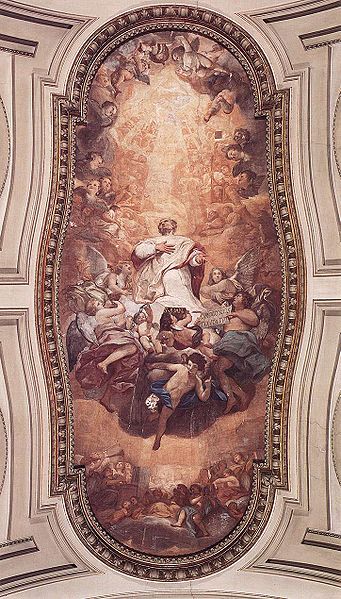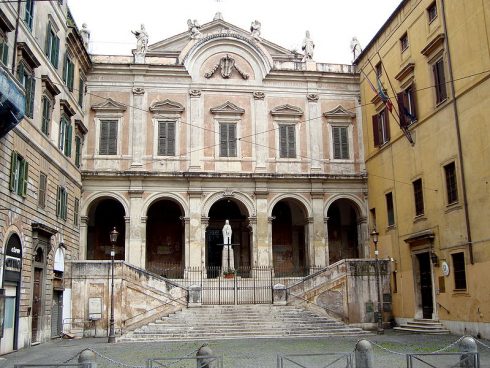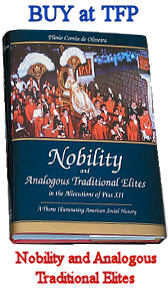St. Eusebius of Rome
A presbyter at Rome; date of birth unknown; d. 357(?). He was a Roman patrician and priest, and is mentioned with distinction in Latin martyrologies. The ancient genuine martyrology of Usuard styles him confessor at Rome under the Arian emperor Constantius and adds that he was buried in the cemetery of Callistus. Some later martyrologies call him a martyr.
 The “Acta Eusebii”, discovered in 1479 by Mombritius and reproduced by Baluze in his “Miscellanea” (1678-1715), tell the following story: When Pope Liberius was permitted by Constantius to return to Rome, supposedly at the price of his orthodoxy, by subscribing to the Arian formula of Sirmium, Eusebius, a priest, an ardent defender of the Nicene Creed, publicly preached against both pope and emperor, branding them as heretics. When the orthodox party who supported the antipope Felix were excluded from all the churches, Eusebius continued to hold Divine service in his own house. He was arrested and brought before Liberius and Constantius. Here he boldly reproved Liberius for deserting the Catholic Faith. In consequence he was placed in a dungeon, four feet wide (or was imprisoned in his own house), where he spent his time in prayer and died after seven months. His body was buried in the cemetery of Callistus with the simple inscription: “Eusebio homini Dei”. This act of kindness was performed by two priests, Gregory and Orosius, friends of Eusebius. Gregory was put into the same prison and also died there. He was buried by Orosius, who professes to be the writer of the Acts.
The “Acta Eusebii”, discovered in 1479 by Mombritius and reproduced by Baluze in his “Miscellanea” (1678-1715), tell the following story: When Pope Liberius was permitted by Constantius to return to Rome, supposedly at the price of his orthodoxy, by subscribing to the Arian formula of Sirmium, Eusebius, a priest, an ardent defender of the Nicene Creed, publicly preached against both pope and emperor, branding them as heretics. When the orthodox party who supported the antipope Felix were excluded from all the churches, Eusebius continued to hold Divine service in his own house. He was arrested and brought before Liberius and Constantius. Here he boldly reproved Liberius for deserting the Catholic Faith. In consequence he was placed in a dungeon, four feet wide (or was imprisoned in his own house), where he spent his time in prayer and died after seven months. His body was buried in the cemetery of Callistus with the simple inscription: “Eusebio homini Dei”. This act of kindness was performed by two priests, Gregory and Orosius, friends of Eusebius. Gregory was put into the same prison and also died there. He was buried by Orosius, who professes to be the writer of the Acts.
It is generally admitted that these Acts were a forgery either entirely or at least in part, and written in the same spirit if not by the same hand, as the notice on Liberius in the “Liber Pontificalis”. The Bollandists and Tillemont point out some grave historical difficulties in the narrative, especially the fact that Liberius, Constantius and Eusebius were never in Rome at the same time. Constantius visit Rome but once, and remained there for about a month, and Liberius was then still in exile. Some, taking for granted the alleged fall of Liberius, would overcome this difficulty by stating that, at the request of Liberius, who resented the zeal of the priest, the secular power interfered and imprisoned Eusebius. It is not at all certain whether Eusebius died after the return of Liberius, during his exile, or even much before that period.

Sant’Eusebio Church on the Esquiline in Rome is said to have been built on the site of his house. Photo by LPLT.
The feast of St. Eusebius is kept on 14 August. The church of the Equiline in Rome dedicated to him, said to have been built on the site of his house, is mentioned in the acts of a council held in Rome under Pope Symmachus in 498 (Manai, VIII, 236-237), and was rebuilt by Pope Zacharias. Formerly it had a statio on the Friday after the fourth Sunday in Lent. It once belonged to the Celestines (an order now extinct); Leo XII gave it to the Jesuits. A good picture representing the triumph of Eusebius, by Anton Raphael Mengs, 1759 is on the ceiling. San Eusebio is the title of the cardinal-priest. The title was transferred by Gregory XVI, but restored by Pius IX.
Francis Mershman (Catholic Encyclopedia)






